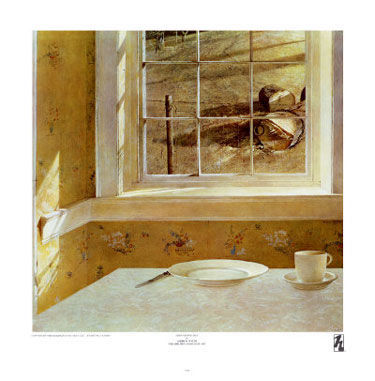
Groundhog Day
Andrew Wyeth Groundhog Day
In many Andrew Wyeth prints, there exists a distinguishing bleak atmosphere. He depicts simplistic and rustic scenes that have a mournful, yet poetic, quality to them. The dichotomy in Andrew Wyeth Groundhog Day prints is intriguing. Outside the window is a gloomy scene. The grass is brown and dead, and there lies a fallen tree with jagged edges. The barbed wire fence and metal chain add a harsh touch. This exterior scene has strong connotations of death.
Andrew Wyeth was said to be preoccupied with death, which gave his paintings a morbid essence to them. The room depicted in the painting is, by contrast, surprisingly orderly and colorful. The dishes are delicately placed; the white tablecloth is fresh and crisp-looking. The space is unadorned, but very clean. The wallpaper is flowery. The whole room appears to mock the scene beyond the window sill. The window, which is a recurring motif in many Andrew Wyeth prints, seems to act as a barrier between the inner order and the outer chaos. However, although it separates the two, it also keeps them connected, just as life and order cannot exist without death and chaos.